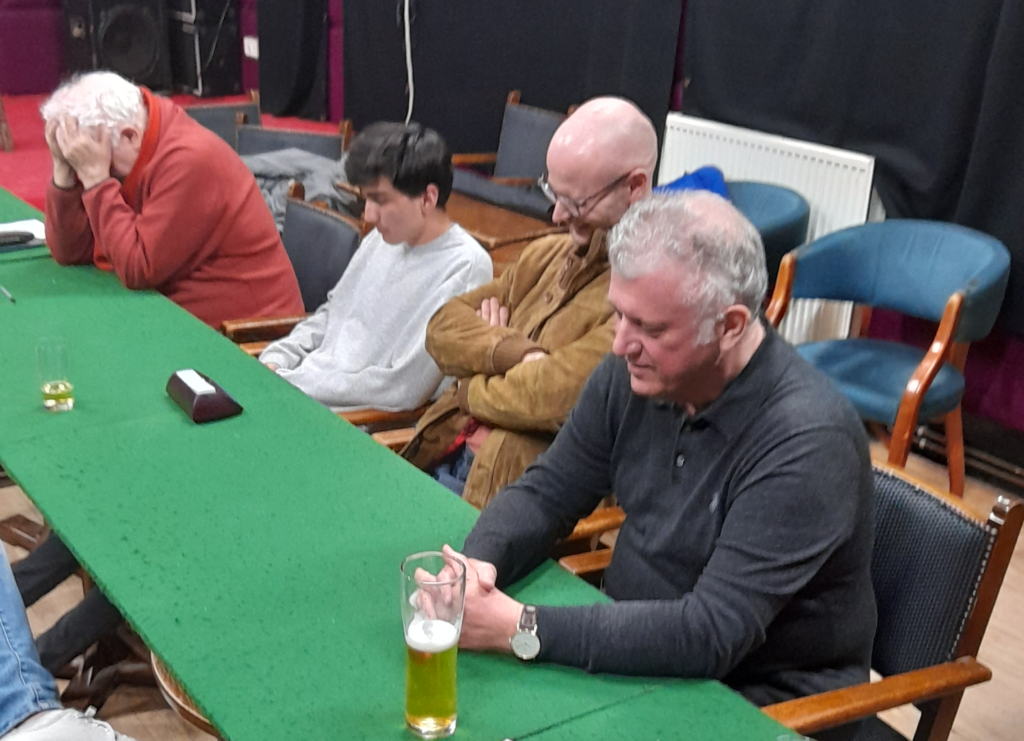Inspired by David Maycock’s theory that spending too much time looking at the board is inhibiting, we spent an evening playing chess in our heads … and our imaginations
John Foley
At our club night on Monday 28 March, we explored the theme of playing chess without looking at the board. The evening started with a talk from David Maycock on how he has been developing this technique over recent months. His argument is that if you can visualise the board, then calculating variations becomes much easier. As a simple example, when you are staring at the board and start to analyse a variation you might move a piece in your head but when that piece still remains in vision it interferes with the thought process and you falsely place it on its physical square rather than the square it moved to in your head.

The argument for blindfold chess would be convincing but for the reluctance of many people to give it a try. Hence, we prepared to overcome this reluctance by means of some simple exercises devised by Peter Lalić, who is also a becoming a proponent of the “no looking” approach to playing chess. Peter prepared exercises in which players were paired with each other to play blindfold a simple pawn game on a 3×3 board. This was then followed up by a pawn game on a 4×4 board. Of course, there were no boards – all the physical equipment was removed before the exercises.
It should also be pointed out that “blindfold” does not mean that the players were wearing a mask around their eyes but simply that they were not looking at a physical board. When Magnus Carlsen was featured playing a simultaneous display against players from corporate America, he wore a substantial blindfold. However, this was more to suit the cameras than out of necessity. It looks impressive, but the blindfold is not necessary.
Some of our leading club members suffer from aphantasia – the inability to form any mental images. Stephen Moss readily accepted that he suffers from a mild form of this affliction but did manage to get through the 3×3 game stage, although the 4×4 game was going too far and he lost comprehensively, choosing the wrong one of two possible pawn moves and seeing (or rather not seeing) his opponent clean up.
We had an interesting discussion about why many of the world’s top players get up from the board and wander about. Clearly they are still thinking about the game. Sometimes they return to the board only to make their move. Our inference is that the ability to visualise the game is an important indicator of chess strength. At some point in every game, a critical position is reached. It is necessary to carry out some serious analysis. In these circumstances, it must be a huge advantage to have a clear mental vision of the board in order to construct a variation tree. Strong players are invariably good at blitz chess – perhaps this quickness of vision is also related to their visualisation ability.
Vladimir Li recalled a point made by Jacob Aagaard, the Danish grandmaster and former British champion, in one of his books: that to be an efficient mental analyst you should not keep reverting to the current position. Instead, you should analyse ahead to the critical position and thereafter use that as the staging post for subsequent analysis of variations. It would be a significant advantage for a player to be looking ahead several moves not from the current position but from a future position derivable, perhaps through forced moves, from the current position.
The evening ended with a grand final of blindfold non-consulting pairs. This paired John Foley and David Maycock against Peter Lalić and Alan Scrimgour. The pairs were not permitted to talk to each other – only to give meaningful glances which could be misinterpreted. I have never played blindfold chess previously, so did not fancy our chances, but surprisingly managed to find some moves which were not terrible.

The four players sat alongside each other in a state of mental distress, with the display board behind us being operated by David Shalom and Vladimir Li. As we called out our moves, the assembled audience veered from fascination to amusement and finally admiration regarding the match. The game would not merit being featured on the Games section of the Kingston website but is a droll divertissement for the blog.
